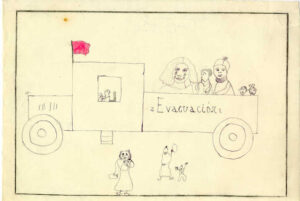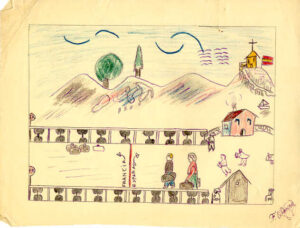The Spanish Civil War displaced upwards of 200,000 children who fled from violence and hunger. Spanish businessman Jose Weissberger, who worked closely with the New York-based Child Welfare Association, sent a cablegram in 1938 warning that: “Terrifying shortage cod liver oil [stop] Milk supply rapidly dwindling [stop] Sugar situation even worse [stop].”
In a number of drawings the children depicted the ordeal of their evacuation and flight. This visual evidence suggests how traumatic the experience was for them.
 Margarita Garcia, aged ten, drew an image of her evacuation (at left). The central figure that immediately catches our eye is a weeping girl who we take to be Margarita. Enormous tears roll down her face as she looks directly at us. Her sorrow dwarfs everything else. The fact that she depicts herself much larger than all the other figures reveals an emotional truth. For the young artist there is only the sorrow of displacement. Other children depict their evacuation differently.
Margarita Garcia, aged ten, drew an image of her evacuation (at left). The central figure that immediately catches our eye is a weeping girl who we take to be Margarita. Enormous tears roll down her face as she looks directly at us. Her sorrow dwarfs everything else. The fact that she depicts herself much larger than all the other figures reveals an emotional truth. For the young artist there is only the sorrow of displacement. Other children depict their evacuation differently.
 Teresa Vazquez, 13, shows no individual features in drawing her evacuation. All the people, both those leaving and those bidding them farewell from the roadside, are tiny stick figures. Hearse-like vehicles transport the evacuees, whom we glimpse between the gathered curtains, as though clutched in the black teeth of a monster.
Teresa Vazquez, 13, shows no individual features in drawing her evacuation. All the people, both those leaving and those bidding them farewell from the roadside, are tiny stick figures. Hearse-like vehicles transport the evacuees, whom we glimpse between the gathered curtains, as though clutched in the black teeth of a monster.
 Mercedes Comellas Ricart, age 13, depicts the interruption of her family’s evacuation by an air raid. Notice the futuristic train that waits to whisk them to safety. Its sleek, streamlined contours stand in contrast to the black, jagged mouth of the shelter in the hill behind the station.
Mercedes Comellas Ricart, age 13, depicts the interruption of her family’s evacuation by an air raid. Notice the futuristic train that waits to whisk them to safety. Its sleek, streamlined contours stand in contrast to the black, jagged mouth of the shelter in the hill behind the station.
 Yet another scene shows a family fleeing Iran into France. Fernando Olavera, age 13, has sketched the bridge, the border and the refugee couple in great detail. The church in the upper right-hand corner received special attention. The neatly lettered legend on the hill explains why: “San Marcial taken by the fascists.” The refugees take flight because the fascists have occupied San Marcial.
Yet another scene shows a family fleeing Iran into France. Fernando Olavera, age 13, has sketched the bridge, the border and the refugee couple in great detail. The church in the upper right-hand corner received special attention. The neatly lettered legend on the hill explains why: “San Marcial taken by the fascists.” The refugees take flight because the fascists have occupied San Marcial.